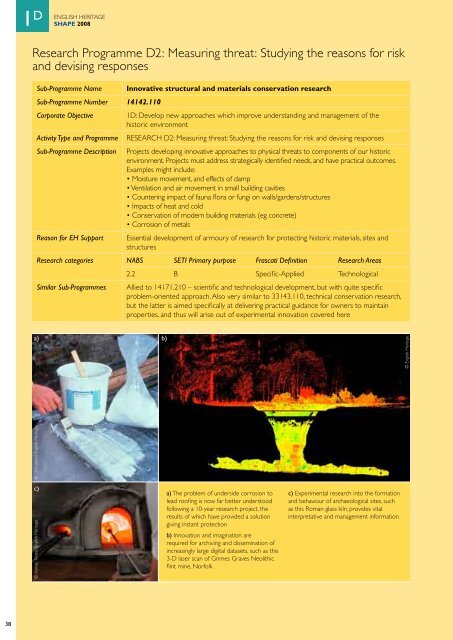shape | pdf - English Heritage
shape | pdf - English Heritage
shape | pdf - English Heritage
Create successful ePaper yourself
Turn your PDF publications into a flip-book with our unique Google optimized e-Paper software.
english heritage<br />
<strong>shape</strong> 2008<br />
1 D Sub-Programme Name<br />
Sub-Programme Number 14142.110<br />
Corporate Objective<br />
Activity Type and Programme<br />
Sub-Programme Description<br />
Reason for EH Support<br />
Similar Sub-Programmes<br />
a) The problem of underside corrosion to<br />
Research Programme D2: Measuring threat: Studying the reasons for risk<br />
and devising responses<br />
Innovative structural and materials conservation research<br />
1D: Develop new approaches which improve understanding and management of the<br />
historic environment<br />
RESEARCH D2: Measuring threat: Studying the reasons for risk and devising responses<br />
Projects developing innovative approaches to physical threats to components of our historic<br />
environment. Projects must address strategically identified needs, and have practical outcomes.<br />
Examples might include:<br />
• Moisture movement, and effects of damp<br />
• Ventilation and air movement in small building cavities<br />
• Countering impact of fauna flora or fungi on walls/gardens/structures<br />
• Impacts of heat and cold<br />
• Conservation of modern building materials (eg concrete)<br />
• Corrosion of metals<br />
Essential development of armoury of research for protecting historic materials, sites and<br />
structures<br />
Research categories NABS SETI Primary purpose Frascati Definition Research Areas<br />
2.2 b Specific-Applied Technological<br />
Allied to 14171.210 – scientific and technological development, but with quite specific<br />
problem-oriented approach. Also very similar to 33143.110, technical conservation research,<br />
but the latter is aimed specifically at delivering practical guidance for owners to maintain<br />
properties, and thus will arise out of experimental innovation covered here<br />
a)<br />
b)<br />
© Chris Wood, <strong>English</strong> <strong>Heritage</strong><br />
© <strong>English</strong> <strong>Heritage</strong><br />
c)<br />
© Barney Sloane, <strong>English</strong> <strong>Heritage</strong><br />
lead roofing is now far better understood<br />
following a 10-year research project, the<br />
results of which have provided a solution<br />
giving instant protection<br />
b) Innovation and imagination are<br />
required for archiving and dissemination of<br />
increasingly large digital datasets, such as this<br />
3-D laser scan of Grimes Graves Neolithic<br />
flint mine, Norfolk<br />
c) Experimental research into the formation<br />
and behaviour of archaeological sites, such<br />
as this Roman glass kiln, provides vital<br />
interpretative and management information<br />
38

















